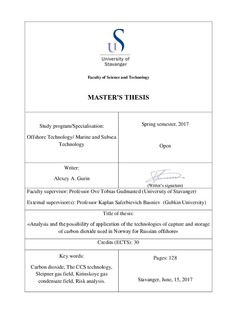Analysis and the possibility of application of the technologies of capture and storage of carbon dioxide used in Norway for Russian offshore
Master thesis
Permanent lenke
http://hdl.handle.net/11250/2460100Utgivelsesdato
2017-06-15Metadata
Vis full innførselSamlinger
Sammendrag
Global climate change is long-term risk related to the accumulation of carbon dioxide (CO2) and other greenhouse gases in the atmosphere. Development and use of capture and storage technology in the underground formations contribute to the reduction of CO2 emissions to the atmosphere. The objective of this thesis is to analyse technology for capture and storage of carbon dioxide used in Norway. The second objective is to make an application analysis of the technology of capture and storage of carbon dioxide on Russian shelf. Risk analysis connected with carbon dioxide storage is the third objective of the paper. The thesis supports the idea of climate change stabilisation about the global reduction of CO2 emission. The method under research is the technology of capture and storage of CO2. This method has been already adopted/tested in such countries as Norway and Australia. The research is based on technology adopted in the Sleipner gas field in Norway. This development was the world’s first demonstration of CCS technology for a deep saline reservoir. Removing carbon dioxide mechanism represents a conventional amine based process. Trapping mechanism of CO2 is performed by creating a concentrated stream of CO2 by applying high pressure. This makes it easy to transport CO2 through the pipeline to storage. From an economic point of view, pipelines are a preferred method for long distance transportation of considerable amounts of CO2. Depleted oil and gas fields are regarded as safe reservoirs for storage of CO2 due to the historical trapping of oil, gas and quite often carbon dioxide as a natural gas mixture in millions of years. From an economic point of view, the benefits may not outweigh the extra costs of CO2 capture, but at the same time, there are known cases in which when injection of CO2 into declining oil fields increased oil recovery.
Beskrivelse
Master's thesis in Offshore technology: Marine and subsea technology
